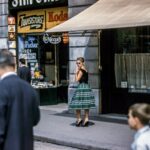The 19th century marked a period of significant transformation in men’s fashion. This era witnessed the emergence of the well-dressed gentleman, who placed great importance on his appearance and adhered to a refined style. Men’s fashion during this time was characterized by an emphasis on tailoring, high-quality fabrics, and meticulous attention to detail.
Clothing served as an indicator of social status and wealth, with the upper classes establishing fashion trends that were subsequently adopted by other social strata. Several key elements became integral to men’s fashion in the 1800s, including the frock coat, waistcoat, and top hat. These items were considered essential components of a gentleman’s wardrobe.
The Romantic movement, which emphasized individuality and self-expression, also influenced men’s fashion during this period. This led to a greater diversity in clothing styles, with an increased variety of colors, patterns, and fabrics gaining popularity. Men’s fashion in the 19th century reflected the changing societal attitudes and values of the time.
The well-dressed gentleman of this era embodied ideals of refinement and sophistication, which were expressed through his clothing choices. The fashion trends established during this period continue to exert influence on men’s fashion in the present day.
Key Takeaways
- 1800s men’s fashion was characterized by tailored suits, top hats, and cravats, reflecting a sense of formality and elegance.
- The evolution of men’s clothing in the 1800s saw the transition from elaborate and ornate styles to more streamlined and practical designs.
- Key elements of the dapper gentlemen’s wardrobe included frock coats, waistcoats, and tailored trousers, emphasizing a polished and refined appearance.
- Social class played a significant role in men’s fashion, with the upper class showcasing their wealth through luxurious fabrics and intricate details, while the working class opted for more functional and durable attire.
- Accessories and grooming were essential for the dapper gentlemen, with items such as pocket watches, walking sticks, and well-maintained beards adding to their overall sophisticated look.
- The legacy of 1800s men’s fashion can be seen in modern style, with elements such as tailored suits, waistcoats, and classic grooming techniques continuing to influence men’s fashion today.
- Tips for embracing the dapper gentlemen’s style today include investing in quality tailored pieces, paying attention to grooming and accessories, and embracing a sense of refinement and sophistication in one’s appearance.
The Evolution of Men’s Clothing in the 1800s
The Regency Era’s Influence
At the beginning of the century, men’s fashion was heavily influenced by the Regency era, characterized by high-waisted trousers, tailcoats, and cravats. These styles dominated the early 1800s, setting the tone for the fashion of the time.
The Rise of the Frock Coat and Top Hat
As the century progressed, the Regency era’s styles gave way to the more structured and tailored looks of the Victorian era. The frock coat became a staple of men’s fashion, often worn with a waistcoat and trousers. The top hat also became a popular accessory, adding a touch of elegance to gentlemen’s ensembles.
Technological Advancements and the Democratization of Fashion
The latter half of the 1800s saw significant technological advancements that revolutionized men’s clothing. The invention of the sewing machine made it easier to produce tailored garments, leading to a greater emphasis on fit and silhouette. New dyeing techniques also allowed for a wider range of colors and patterns to be used in men’s clothing. These advancements led to a greater diversity in men’s fashion, making different styles and looks more accessible to a wider range of men.
Key Elements of the Dapper Gentlemen’s Wardrobe
The dapper gentleman of the 1800s had a distinct wardrobe that was characterized by several key elements. One of the most iconic pieces of clothing from this era was the frock coat, which was a long, tailored coat with a fitted waist and flared skirt. The frock coat was typically worn with a waistcoat and trousers, creating a polished and sophisticated look.
Another essential item in the dapper gentleman’s wardrobe was the waistcoat, which was often made from luxurious fabrics such as silk or velvet. The waistcoat added an extra layer of refinement to the ensemble and was often worn in a contrasting color or pattern to create visual interest. Accessories were also an important part of the dapper gentleman’s wardrobe, with items such as cravats, top hats, and gloves being essential for completing the look.
Cravats were worn around the neck in place of a traditional tie and were often made from silk or satin for a luxurious touch. Top hats were a symbol of status and were often worn for formal occasions, adding an air of sophistication to the dapper gentleman’s ensemble. Gloves were also an important accessory for men during this time, with leather gloves being worn for outdoor activities and formal events alike.
Overall, the key elements of the dapper gentleman’s wardrobe were characterized by fine tailoring, luxurious fabrics, and attention to detail.
The Influence of Social Class on Men’s Fashion
| Social Class | Fashion Preferences | Spending Habits |
|---|---|---|
| Upper Class | Elegant and luxurious clothing | High spending on designer brands |
| Middle Class | Classic and practical clothing | Moderate spending on quality items |
| Lower Class | Functional and affordable clothing | Low spending on fashion items |
Social class played a significant role in shaping men’s fashion during the 1800s. The upper classes set the trends for men’s clothing, with wealthy gentlemen often wearing elaborate and luxurious ensembles that reflected their status and wealth. The frock coat, waistcoat, and top hat were all symbols of social standing, with finer fabrics and more intricate detailing being reserved for those in higher social positions.
Lower-class men often emulated the styles of the upper classes as best they could, but their clothing was typically simpler and more practical in nature. The influence of social class on men’s fashion also extended to grooming and personal care. Wealthy gentlemen often had access to grooming products and services that were not available to lower-class men, allowing them to maintain a polished and refined appearance.
This divide in grooming practices further emphasized the distinction between social classes and contributed to the overall hierarchy of 1800s society. Overall, social class had a profound impact on men’s fashion during the 1800s, with clothing and grooming practices serving as visible markers of one’s place in society.
Accessories and Grooming for the Dapper Gentlemen
Accessories played a crucial role in defining the dapper gentleman’s style during the 1800s. One of the most iconic accessories from this era was the cravat, which was worn around the neck in place of a traditional tie. Cravats were often made from luxurious fabrics such as silk or satin and were tied in elaborate knots to add visual interest to the ensemble.
Another essential accessory for dapper gentlemen was the top hat, which added a touch of elegance to formal outfits. Top hats were often made from felt or silk and were worn for special occasions such as weddings or horse races. Grooming was also an important aspect of maintaining a dapper appearance during the 1800s.
Wealthy gentlemen often had access to grooming products such as pomades, tonics, and colognes that were used to style their hair and maintain a polished appearance. Shaving was also an important part of grooming for dapper gentlemen, with straight razors being used to achieve a clean-shaven look. Overall, accessories and grooming played a crucial role in defining the dapper gentleman’s style during the 1800s, with attention to detail being key to achieving a refined appearance.
The Legacy of 1800s Men’s Fashion in Modern Style

Classic Silhouettes Revived
Many elements of 1800s fashion have been reinterpreted and incorporated into contemporary menswear, reflecting a continued appreciation for classic tailoring and timeless style. The frock coat, waistcoat, and top hat have all made appearances in modern fashion collections, with designers putting their own spin on these iconic pieces.
Accessories Make a Comeback
Additionally, accessories such as cravats and gloves have experienced a resurgence in popularity, adding a touch of old-world charm to modern ensembles.
Timeless Grooming Traditions
The legacy of 1800s men’s fashion can also be seen in grooming trends, with traditional grooming practices such as straight razor shaving experiencing a revival in recent years. Many men have embraced classic grooming products such as pomades and tonics as part of their daily routine, appreciating their ability to achieve a polished and refined appearance.
The legacy of 1800s men’s fashion continues to influence modern style, with its emphasis on tailoring, attention to detail, and timeless elegance remaining relevant in today’s fashion landscape.
Tips for Embracing the Dapper Gentlemen’s Style Today
For those looking to embrace the dapper gentleman’s style today, there are several key tips to keep in mind. First and foremost, investing in well-tailored clothing is essential for achieving a polished and refined look. Whether it’s a tailored suit or a well-fitted waistcoat, clothing that fits properly is key to achieving an elegant appearance.
Additionally, paying attention to details such as accessories and grooming is crucial for capturing the essence of dapper style. When it comes to accessories, opting for classic pieces such as pocket squares, cufflinks, and leather gloves can add a touch of sophistication to any ensemble. These timeless accessories can elevate even the simplest outfit and are essential for achieving a dapper look.
In terms of grooming, embracing traditional grooming practices such as straight razor shaving or using pomades can help achieve a polished appearance that is reminiscent of 1800s style. Overall, embracing the dapper gentleman’s style today is about paying attention to details, investing in quality clothing, and embracing timeless grooming practices. By incorporating elements of 1800s fashion into modern ensembles, men can capture the elegance and refinement that defined the dapper gentleman of this iconic era.
If you’re interested in learning more about 1800s men’s fashion, you should check out this article on Extra Quirky. They have a great piece on the evolution of men’s fashion during the 1800s, including details on popular styles, fabrics, and accessories of the time. It’s a fascinating look at how men’s fashion has changed over the years and how it continues to influence modern trends.
FAQs
What were the common clothing items worn by men in the 1800s?
In the 1800s, men commonly wore tailored suits, waistcoats, trousers, top hats, cravats, and dress shirts. The style was formal and often included layers of clothing.
What were the popular fabrics used in men’s clothing during the 1800s?
Common fabrics used in men’s clothing during the 1800s included wool, cotton, linen, and silk. These fabrics were used to create the tailored suits, waistcoats, and other garments that were popular during the time.
What were the typical colors and patterns used in men’s fashion during the 1800s?
Men’s fashion in the 1800s often featured dark and neutral colors such as black, navy, brown, and gray. Patterns such as stripes, plaids, and houndstooth were also popular, especially in waistcoats and accessories.
What were the key accessories worn by men in the 1800s?
Key accessories worn by men in the 1800s included top hats, pocket watches, walking sticks, gloves, cravats, and bow ties. These accessories were often used to add a touch of elegance and formality to the overall look.
How did men’s fashion in the 1800s differ based on social class?
Men’s fashion in the 1800s varied based on social class. Wealthier men could afford tailored suits made of finer fabrics, while working-class men often wore simpler, more practical clothing for their daily activities. The quality of materials and the level of tailoring were key indicators of social status.









